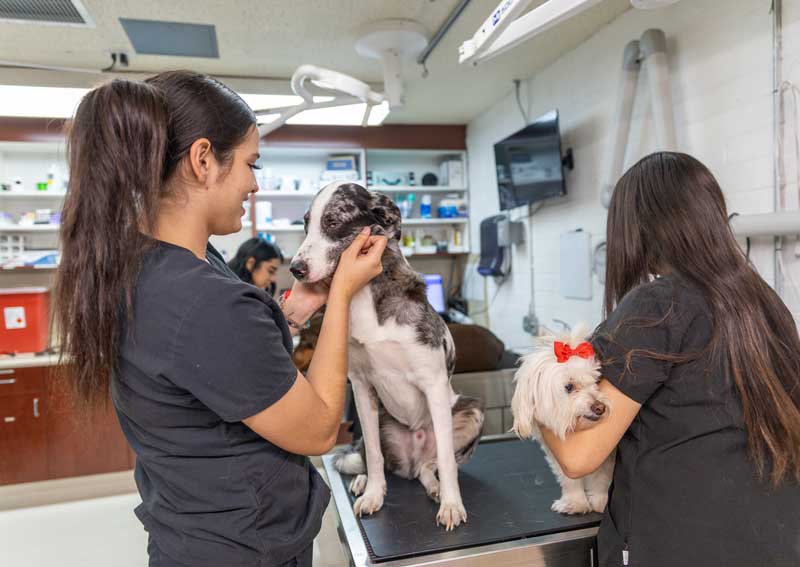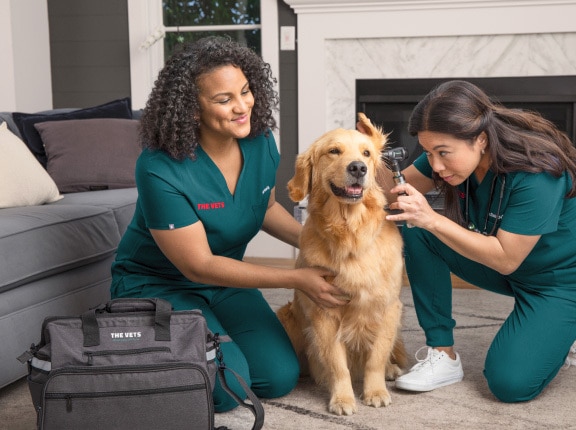Complete Owner’s Guide to Appointments With a veterinary cardiologist near me
Wiki Article
Everything About Vet Surgical Treatment: Understanding the Importance of Professional Treatment for Your Animals
Vet surgical procedure is an essential part of family pet healthcare. It incorporates different treatments, from regular elective surgeries to urgent treatments. Comprehending the complexities of these surgical procedures can help family pet owners make notified choices. The prep work, implementation, and recovery stages are essential for ensuring the health of pets. With appropriate expertise, proprietors can navigate the intricacies of vet treatment. What factors should be thought about prior to a pet dog undergoes surgical procedure?Kinds Of Veterinarian Surgeries
When a pet dog calls for medical treatment, understanding the numerous kinds of veterinarian surgeries can help pet owners make notified choices. Vet surgeries can be extensively classified right into 3 major types: optional, immediate, and emergency surgeries. Elective surgeries, such as spaying or neutering, are prepared treatments that are not quickly serious. Immediate surgical procedures, like those for international body elimination, must be done soon yet are not dangerous in the minute. Emergency situation surgical treatments, such as those addressing serious trauma or inner blood loss, are vital and need instant attention.Additionally, surgical procedures can differ in complexity, varying from minimally invasive laparoscopic treatments to much more extensive open surgeries. Each kind of surgery carries its very own dangers and healing processes. Comprehending these classifications allows family pet proprietors to participate in meaningful discussions with veterinarians, causing much better outcomes for their beloved animals.Planning for Your Family pet's Surgical treatment
Preparing for a pet's surgery includes an extensive checklist to ensure all fundamentals are covered. Efficient communication with the vet is important for recognizing the procedure and any type of necessary pre-operative steps - canine tplo surgery. Additionally, having clear post-operative care directions will assist owners give the most effective support for their recouping family petsPre-Surgery Checklist Basics
Assuring a smooth medical experience for an animal needs mindful preparation and attention to detail. A pre-surgery checklist is vital for pet proprietors to comply with. Verifying the set up surgery day and time is important. Proprietors should additionally verify that their family pet has actually not eaten according to the veterinarian's directions, normally for 8-12 hours before surgical treatment. Gathering needed clinical records, including inoculation background, is necessary for the vet's testimonial. It is likewise suggested to prepare a comfortable area in the house for the pet's recovery after surgical procedure. Proprietors need to have a strategy for transport to and from the vet facility, making certain that the family pet is secure and comfortable throughout the journey. Complying with these actions can substantially boost the medical experience.Connecting With Your Veterinarian

Efficient communication with the vet is crucial for a successful surgical experience for family pets. Proprietors ought to be prepared to review their pet's case history, consisting of any kind of pre-existing problems, medicines, and allergies. This details helps the veterinarian evaluate risks and tailor the medical strategy appropriately. Furthermore, family pet proprietors must ask questions concerning the procedure, anesthesia, and expected end results to assure they totally understand the process. Clarifying any questions can alleviate stress and anxiety for both the animal and the proprietor. It is likewise important to interact any type of behavioral modifications or concerns observed in the family pet leading up to the surgical procedure. Ultimately, clear discussion cultivates depend on and partnership, making certain that pets get the very best possible treatment throughout their medical journey.
Post-Operative Care Directions
After reviewing the surgery with the veterinarian, family pet proprietors should concentrate on post-operative care directions to facilitate a smooth healing for their animals. These instructions commonly include monitoring the surgical website for signs of infection, such as soreness or discharge. Family pets may need to be kept tranquil and constrained to protect against extreme motion that might disrupt recovery. Discomfort administration is important, so proprietors should comply with the veterinarian's assistance on carrying out medications. Additionally, nutritional constraints might be encouraged to avoid gastrointestinal distress. Regular follow-up visits are very important to assure appropriate recovery and address any type of problems. By sticking to these post-operative treatment guidelines, pet dog owners can greatly add to their family pet's healing and general health.The Surgical Process Explained
The surgical process for animals includes vital steps that guarantee their safety and security and healing. Pre-surgery preparations are crucial for lessening dangers, while post-operative treatment guidelines play a crucial duty in advertising healing. Comprehending these parts assists pet dog owners navigate the surgical experience much more properly.Pre-Surgery Preparations
Prior to a pet dog goes through surgical treatment, a number of essential preparations should take area to ensure a safe and successful procedure. A comprehensive vet examination is important to analyze the pet's overall health and wellness and identify any type of prospective risks. This might include blood tests, imaging, or other diagnostics. The vet will additionally talk about anesthesia choices tailored to the pet dog's certain needs. In addition, animal proprietors are typically advised to hold back food and water for a defined time prior to surgical treatment to reduce the he said danger of difficulties throughout anesthesia. It is essential for proprietors to offer a full clinical history, including any kind of medications or allergic reactions, ensuring the medical team has all essential information. Correct communication and adherence to pre-surgery standards can significantly improve the end result of the treatment.Post-Operative Care Guidelines
Correct post-operative care is necessary for making certain a pet dog's healing following surgical treatment. After the treatment, animals must be monitored very closely for any type of indicators of issues, such as too much blood loss, swelling, or unusual behavior. It is important to follow the veterinarian's directions concerning medicines, consisting of discomfort relievers and anti-biotics. Pet dogs ought to be kept in a silent, comfortable setting to decrease tension and promote recovery. Limiting activity is pet health care important; short, leashed strolls may vet care near me be essential, yet jumping or running need to be avoided. Regular follow-up consultations should be scheduled to analyze the healing process. Additionally, the medical site has to be kept clean and completely dry, with any type of indicators of infection reported to a veterinarian quickly. Abiding by these standards enhances recovery end results.Anesthesia and Pain Management
Efficient anesthetic and pain administration are important parts of vet surgical procedure, guaranteeing that pets remain comfortable and secure throughout the procedure. Vets assess each pet's specific demands, thinking about aspects such as age, weight, health and wellness condition, and the kind of surgical treatment being performed.Anesthesia protocols generally consist of a combination of pre-anesthetic medications, induction representatives, and inhalant anesthetics, enabling accurate control over the animal's degree of consciousness. Monitoring during surgery is vital; vets constantly observe vital indications to attend to any kind of prospective problems promptly.Pain monitoring methods may entail opioids, non-steroidal anti-inflammatory drugs (NSAIDs), and regional anesthetics, customized to the family pet's details scenario. This complex approach aids minimize discomfort and advertises a smoother medical experience. By prioritizing effective anesthesia and discomfort monitoring, vet professionals enhance the general welfare of pets undergoing operations, guaranteeing they get the greatest criterion of treatment.Post-Operative Care and Recovery
Complying with surgical procedure, the focus moves to post-operative care and recuperation, which is vital for ensuring a pet's risk-free go back to normal activities. Throughout this duration, animals require a quiet, comfortable setting to aid healing. Owners ought to closely check their pet dogs for any kind of indications of pain or uncommon behavior.Veterinary standards frequently consist of particular instructions associated with medicine administration, injury treatment, and nutritional changes. It is vital to follow these suggestions to reduce issues and advertise recovery. Pets may need to be restricted from vigorous tasks, such as running or jumping, throughout their healing period (tplo surgery).Regular follow-up appointments with the vet enable for tracking of the family pet's progression and timely adjustments to the treatment plan. Supplying psychological assistance and friendship can additionally boost an animal's healing experience, aiding to minimize stress and anxiousness. In general, attentive post-operative care plays a significant function in accomplishing a successful healingIdentifying Difficulties After Surgery
Just how can family pet proprietors determine problems after surgery? Recognition of certain indicators is vital for making sure the well-being of pet dogs throughout recuperation. Common signs include extreme swelling, inflammation, or discharge at the surgical website, which might indicate infection. Furthermore, consistent discomfort, suggested by whining or reluctance to move, must motivate immediate interest. Adjustments in appetite or water intake can likewise suggest issues; a reduction in these actions may indicate pain or distress.Moreover, pet owners must check their pet dogs for any type of uncommon actions, such as sleepiness or problem breathing, as these can be indicators of significant concerns. Throwing up or looseness of the bowels following surgical treatment might need immediate veterinary examination. Identifying these difficulties early can substantially impact a pet's healing procedure, highlighting the significance of alertness and punctual communication with a vet for any worrying signs.The Role of Veterinary Professionals in Surgical Treatment
Vet experts play an essential duty in making certain the safety and success of operations for animals, particularly following surgical treatment when keeping track of and treatment are critical. These specialists consist of veterinarians, vet professionals, and assistance personnel, all of whom contribute specialized skills to the medical process.Before surgical treatment, vets carry out thorough analyses to evaluate the pet's wellness, making sure that any type of underlying problems are managed. Throughout the treatment, the medical group gives anesthesia, maintains sterilized settings, and keeps track of crucial signs, very important for lessening risks.Post-operative care is equally significant; veterinary professionals observe for complications, manage discomfort, and guide proprietors on healing practices. Their competence enables them to acknowledge early indications of distress or infection, ensuring timely treatment. Ultimately, the joint efforts of veterinary specialists in surgical treatment cultivate a safe environment, advertising the health of animals throughout the medical journey.
Often Asked Questions
Just how Do I Select the Right Vet Specialist for My Pet?
Picking the best veterinary specialist involves investigating qualifications, reading testimonials, and reviewing the facility's setting. It is necessary to assess the doctor's experience with particular procedures and their communication design when choosing.What Are Usual Misconceptions Regarding Veterinarian Surgeries?
Typical misconceptions about vet surgical procedures include beliefs that they are constantly dangerous, unneeded, or just for emergency situations. Several pet proprietors take too lightly the advantages of preventive procedures and the skill entailed in veterinary surgical care.Just How Much Will My Family pet's Surgical treatment Expense?
The cost of an animal's surgery can vary significantly based on factors such as the kind of procedure, the vet's experience, and geographic area (veterinary cardiologist near me). Generally, expenditures range from a couple of hundred to numerous thousand bucks
Can My Animal Eat Before Surgery?
Prior to surgical treatment, it is typically suggested that pets avoid eating for a specific period. This fasting helps in reducing the risk of difficulties during anesthetic. Owners need to consult their veterinarian for specific instructions tailored to their family pet's needs.Suppose My Family Pet Has Pre-Existing Health Issues?
When a family pet has pre-existing health and wellness problems, it's crucial for the veterinarian to assess these aspects before surgery. This analysis guarantees proper safety measures are taken, lessening threats and optimizing the family pet's total safety and security during the treatment.Report this wiki page